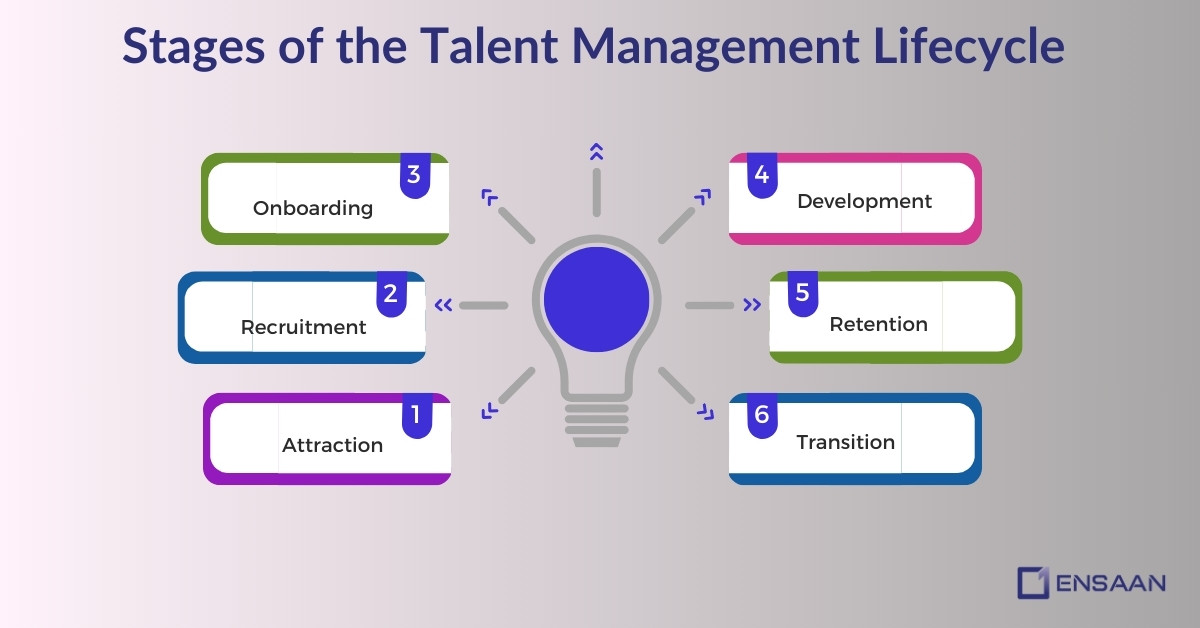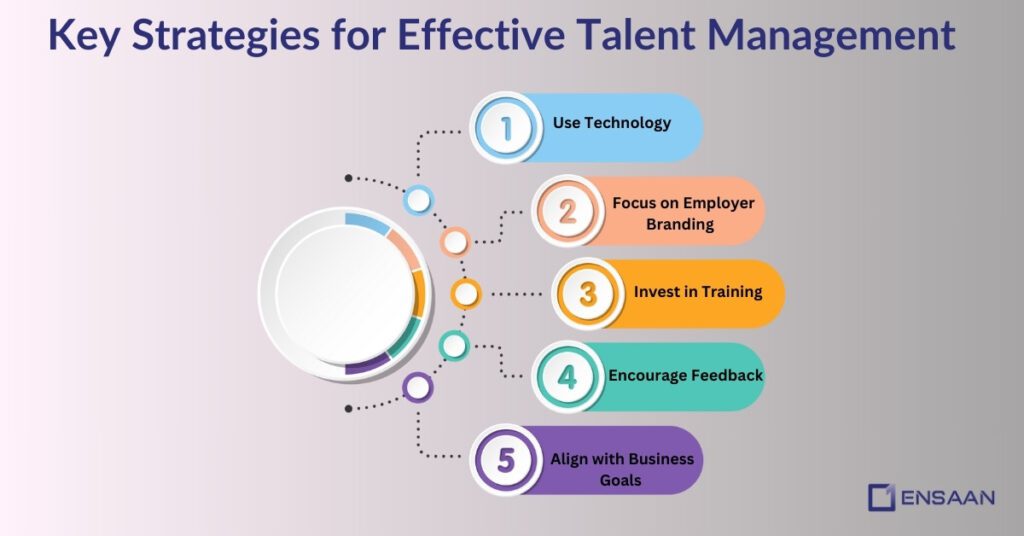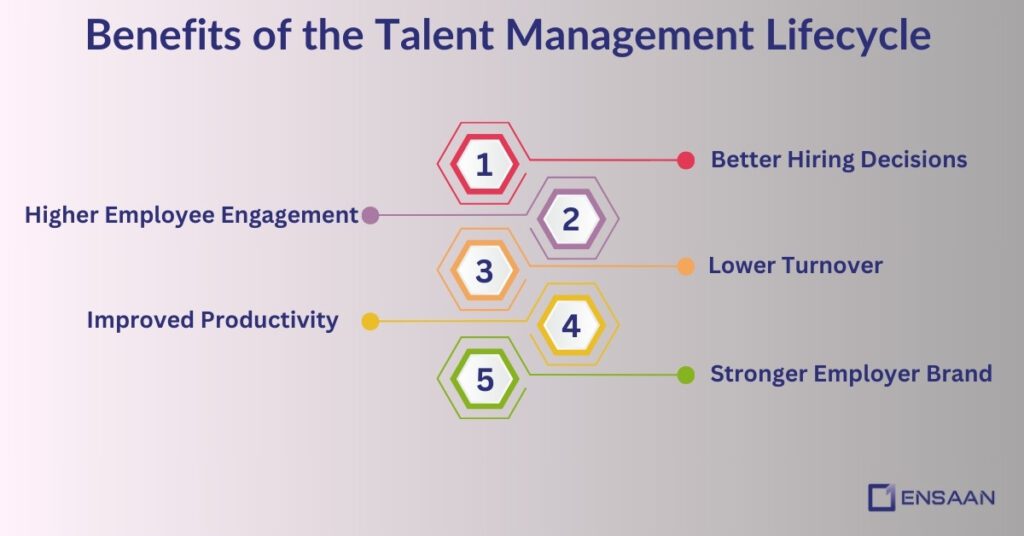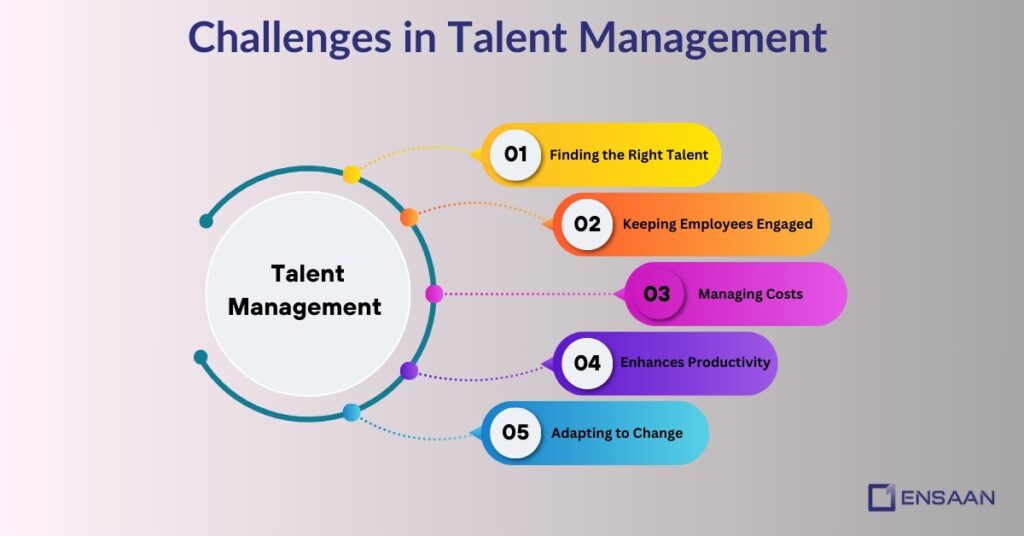Talent Management Lifecycle (TML) is an ongoing process designed to help organizations identify, recruit, train and retain top talent.
By paying attention to every stage of their business’ lifecycle, businesses can ensure they have the appropriate people in key roles – driving growth and success along with them.
In this guide, we’ll break down the Talent Management Lifecycle into simple steps, discuss its significance and offer guidance for effectively incorporating it in your organization.

What is Talent Management?
Talent management is the process of finding, hiring, developing, and keeping skilled employees.
Create a workforce that supports the company’s goals and values.
The Talent Management Lifecycle divides the process of talent management into six stages, each of which has their own focus and strategy.
Consider it as a journey that employees take with your company.
Every interaction counts. From when they first learn of your organization to when they exit it, every moment counts.
By effectively overseeing this journey, you can build a powerful, motivated, and productive team.
Why is the Talent Management Lifecycle Important?

A talent management lifecycle is essential for many reasons:
- Attracts Top Talent: Helps you locate and hire top candidates.
- Boosts Employee Engagement: Provide employees with motivation and satisfaction.
- Improves Retention: Focuses on employee needs by minimizing turnover rates.
- Enhances Productivity: Ensuring employees possess the necessary skills and support for optimal performance is vital in increasing productivity.
- Drives Business Growth: Align workforce capabilities with organizational goals for increased business expansion.
In short, effective talent management helps you build a strong team that can take your business to the next level.
Stages of the Talent Management Lifecycle

The Talent Management Lifecycle includes 6 main stages.
1. Attraction:
This stage aims at drawing talented employees to your organization by building an appealing employer brand and making your company an appealing workplace environment.
Key Activities:
- Building a Positive Company Culture: A great workplace culture attracts top talent. Showcase your values, mission, and work environment.
- Creating Compelling Job Descriptions: Create detailed job descriptions that accurately reflect the role, responsibilities, and benefits of your employment opportunities to draw in candidates who meet all criteria.
- Promoting Job Openings: Take advantage of job boards, social media and employee referrals to spread word of your vacancy to a wide audience.
- Showcasing Benefits: Promote advantages such as flexible work hours, health insurance plans and career advancement opportunities to attract top talent.
- Goal: Your company seeks to attract top talent that aligns with its values and goals.
2. Recruitment:
Once your candidates are identified, the next step should be identifying, interviewing and selecting those most suited for the role.
This process typically includes screening out unsuitable people before final selection.
Key Activities:
- Sourcing Candidates: Use platforms such as LinkedIn, job boards and recruitment agencies to source potential hires.
- Conducting Interviews: Ask questions that assess both skills and cultural fit, to create the optimal interviewing situation.
- Assessments and Tests: Use assessments and tests to evaluate candidates’ abilities and personality traits.
- Checking References: Speak to previous employers to ascertain an applicant’s experience and performance.
- Making Job Offers: Make offers to the top candidates and negotiate terms of employment.
- Goal: Our aim is to hire skilled individuals that match both our company culture and role requirements.
3. Onboarding:
Onboarding is the process of integrating new hires into the company. It’s about helping them feel welcome, understand their role, and get up to speed quickly.
Key Activities:
- Orientation and Training: Provide an introduction to the company, its policies, and the new hire’s role within it.
- Introducing the Team: Help newcomers meet their colleagues and understand team dynamics.
- Setting Expectations: Establish clear job responsibilities, goals and performance measures.
- Providing Resources: Provide tools, access to systems and support to help new hires flourish in their roles.
- Goal: Ensuring new employees feel appreciated and equipped to succeed in their roles.
4. Development:
This stage aims to assist employees in expanding their skillset and moving ahead in their careers by creating opportunities for learning and development.
Key Activities:
- Training Programs: Offer workshops, online courses, and certifications to enhance skills.
- Mentorship and Coaching: Pair employees with mentors who can guide their career growth.
- Career Development Plans: Create personalized plans that outline goals and steps for advancement.
- Encouraging Challenges: Give employees opportunities to take on new projects and responsibilities.
- Goal: Build a skilled and motivated workforce that can take on future challenges.
5. Retention:
Retention is about keeping your top talent engaged and satisfied. It’s crucial to reduce turnover and maintain a stable, productive workforce.
Key Activities:
- Competitive Salaries and Benefits: Offer fair pay and perks like health insurance, retirement plans, and bonuses.
- Recognition and Rewards: Celebrate employee achievements through awards, bonuses, or public recognition.
- Career Growth Opportunities: Provide clear paths for promotion and advancement.
- Positive Work Environment: Foster a culture of respect, collaboration, and work-life balance.
- Goal: Keep employees motivated and committed to the company.
6. Transition:
The final stage involves managing employee exits, whether due to retirement, resignation, or other reasons. It’s about ensuring a smooth transition for both the employee and the company.
Key Activities:
- Exit Interviews: Gather feedback to understand why employees are leaving and how to improve.
- Knowledge Transfer: Ensure departing employees share their knowledge with remaining team members.
- Celebrating Contributions: Acknowledge the employee’s work and celebrate their achievements.
- Maintaining Relationships: Stay in touch with former employees for potential future opportunities.
- Goal: Handle employee departures professionally and maintain a positive employer brand.
Key Strategies for Effective Talent Management

To make the most of the Talent Management Lifecycle, consider these strategies:
1. Use Technology:
Leverage HR software and tools to streamline processes like recruitment, performance tracking, and employee engagement. For example:
- Applicant Tracking Systems (ATS): Simplify hiring by managing resumes and applications.
- Learning Management Systems (LMS): Deliver training programs and track employee progress.
- Performance Management Tools: Monitor employee performance and provide feedback.
2. Focus on Employer Branding:
Build a reputation as a great place to work. Showcase your company culture, values, and employee benefits through:
- Social media.
- Company websites.
- Employee testimonials and reviews.
3. Invest in Training:
Provide ongoing learning opportunities to help employees grow. This could include:
- Workshops and seminars.
- Online courses and certifications.
- Mentorship programs.
4. Encourage Feedback:
Regularly seek input from employees to improve processes. Use surveys, one-on-one meetings, and suggestion boxes to gather feedback.
5. Align with Business Goals:
Ensure your talent management strategies support the company’s objectives. For example:
- Hire employees with skills that match future business needs.
- Develop training programs that align with organizational goals.
- Recognize and reward behaviors that drive success.
Benefits of the Talent Management Lifecycle

Implementing the Talent Management Lifecycle offers several benefits:
- Better Hiring Decisions: Attract and hire candidates who fit your company culture and goals.
- Higher Employee Engagement: Keep employees motivated and satisfied.
- Lower Turnover: Retain top talent by addressing their needs and concerns.
- Improved Productivity: Ensure employees have the skills and support to perform well.
- Stronger Employer Brand: Build a reputation as a great place to work.
Challenges in Talent Management

While the Talent Management Lifecycle offers many benefits, it also comes with challenges:
- Finding the Right Talent: Attracting skilled candidates can be difficult, especially in competitive industries.
- Keeping Employees Engaged: Maintaining high levels of motivation and satisfaction requires ongoing effort.
- Managing Costs: Investing in talent management tools and programs can be expensive.
- Adapting to Change: Businesses must continuously adapt their strategies to meet evolving workforce needs.

Conclusion
The Talent Management Lifecycle is a powerful framework for managing employees effectively.
Focusing on each stage attraction, recruitment, onboarding, development, retention and transition allows you to build an engaged, skilled and robust workforce.
Employee engagement is essential to driving long-term success for any organization, as well as benefitting its employees directly.
Whether you’re a small business or a large enterprise, implementing a well-planned talent management strategy can help you stay competitive and achieve your goals.
By investing in your people, you’re investing in the future of your business.
FAQs
It’s a continuous process that helps organizations attract, develop, motivate, and retain employees throughout their journey in the company.
It helps businesses hire the right people, keep them engaged, and align their skills with organizational goals.
The 6 stages are attraction, recruitment, onboarding, development, retention, and transition.
Use technology, focus on employer branding, invest in training, encourage feedback, and align strategies with business goals.
Better hiring decisions, higher employee engagement, lower turnover, improved productivity, and a stronger employer brand.








